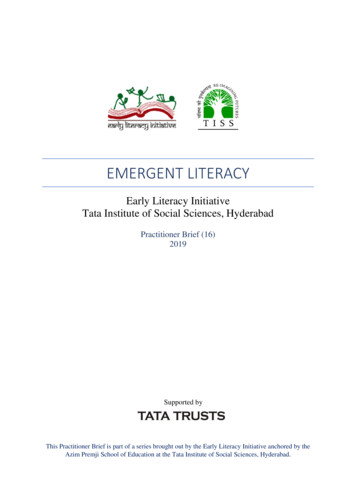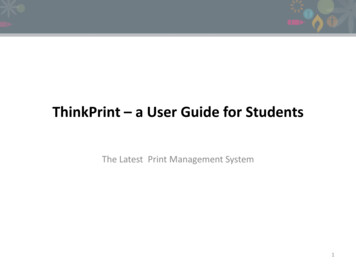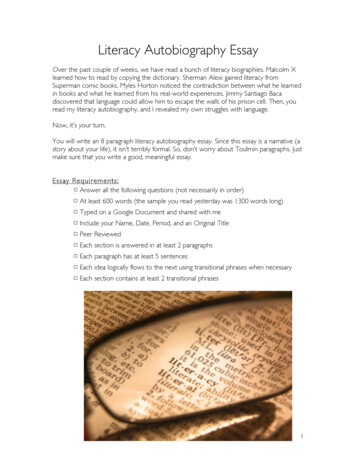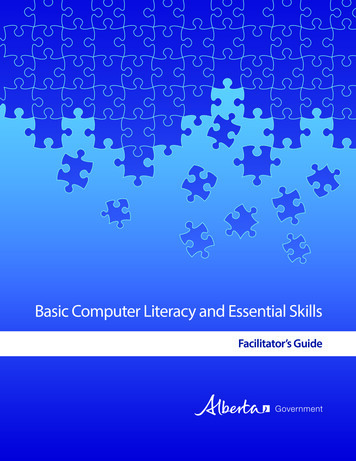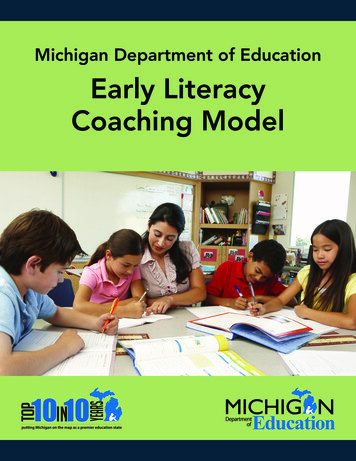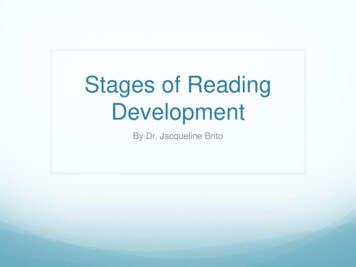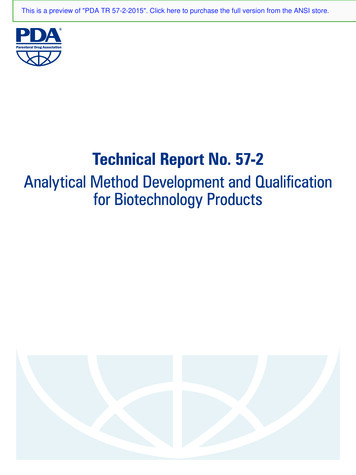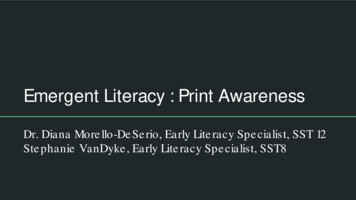
Transcription
Emergent Literacy : Print AwarenessDr. Diana More llo-De Se rio, Early Lite racy Spe cialist, SST 12Ste phanie VanDyke , Early Lite racy Spe cialist, SST8
Today’s Agenda:Entering a World of Print: Young Children’s Development of Print KnowledgeFostering Children’s Engagement with PrintMatching Books with Print- Knowledge Targets
“Take Away’s” from today’s conversationToday’s conve rsation will he lp me to think more critically about how mye ngage me nt with young childre n can e nhance print aware ne ss.Today’s conve rsation will allow me to analyze stude nt work sample s, pe e rinte ractions and whe n appropriate one -on-one asse ssme nt to support theinstruction and activitie s provide d in the e arly le arning classroom.Today’s conve rsation will he lp me with lite racy conve rsations I have with pare ntsand othe r colle ague s.Today’s conve rsation will make me more curious about how to support youngchildre n’s print aware ne ss.
What is Print Awareness?Que stions to re fle ct:1.What is your de finition of print aware ne ss?2.What activitie s foste r print aware ne ss in the classroom?
Essential Components of Early Literacy DevelopmentOr al LanguagePhonologica l Awa r enessPr int KnowledgeSpea king & ListeningConscious a wa r eness of/ a bility to ma nipula tethe sound str uctur es of spoken la ngua gePr int a wa r eness, a lpha betknowledge, being a wr iter
Simple Views .How theory links to InstructionThe Simple View of WritingFoundationalWriting SkillsXComposition Skilled WrittenExpression
Elements of Print and Book AwarenessFunction of Print .How and Why do we use these symbols?Conventions of Print .When and Where do we use different types of symbols?Book Conventions .How do we use these items we call books?
Print AwarenessWhy is Print Awareness Important?Print aware ne ss is important be cause it re pre se nts a group of skills that arene ce ssary for childre n to be come succe ssful re ade rs. Childre n be gin to de ve lopprint aware ne ss as e arly as infancy and continue to de ve lop print aware ne ssthroughout e arly childhood. Childre n from the age s of 3-5 rapidly de ve lop printaware ne ss when adults engage in activities to build their early literacy skills.Without print aware ne ss childre n will not de ve lop le tte r / sound corre sponde nce ,word re ading skills, or the ability to re ad and unde rstand te xt.
Children represent print awareness .When a child holds a book the right way.When a child distinguishes between letters and words.When a child writes scribbles on paper and asks you to read what they wrote.
Ohio’s State Standards & Print Awareness
Ohio’s Early Learning Standards & Print Awareness
Reflection:Whe re , or how, is print aware ne ss be ing foste re d for young childre n, birth- age 8,who will e nte r the doors of your schools?
Entering a World of Print: Young Children’s Development of Print KnowledgeAge s 1 - 5Year One:Childre n may be gin to re cognize the diffe re nce be twe e n print and picture s asthe y look at the page s of storybooks on the laps of the ir pare nts, and pe rhapse ve n are producing proto- writing (Drighting) by scribbling with crayons on pape ror e ve n walls! (pg 2)
Years Two & Three:Children may recognize a few letters on billboards and signs in their environment,and are likely recognizing highly salient words that help them negotiate the worldaround them—such as their own names printed on their cubby at day-care or thetitle of a favorite storybook. Emergent writing may begin (pg 2)
Years 4 & 5:Many children are reading some simple words in storybooks and may identifywords on environmental signs they have seen often. They may even be producingwords and stories in their own writing without the aid of an adult. These emergentwritings provide clear evidence of children’s continual growing knowledge aboutboth the forms and the functions of print (pg 2)
What can educators and parents do?By explicitly and intentionally fostering young children’s awareness of and interestin the print around them—in the home, in the classroom, and in the community—wecan position children on an early and healthy trajectory of reading and writingdevelopment and increase the likelihood that they will be active and lifelongconsumers of the print around them (p 6).Read Aloud .teacher’s can be explicit through print referencingProvide children with authentic experiences to use printHelp children learn letter identification
Verbal references to printAdult ve rbal be haviors, such as que stions and comme nts about print, that incre asechildre n’s contact with print during book- re ading and othe r lite racy activitie s. Sometype s of ve rbal re fe re nce s are e vocative , in that the y e xplicitly se e k to e ngagechildre n in conve rsations or que stion–answe r e xchange s about print. Othe r ve rbalre fe re nce s are non e vocative , in that the y se e k to provide childre n with informationabout print. Que stions about print are ge ne rally e vocative , whe re as comme ntsabout print are ge ne rally non e vocative . (p 34)
Supporting print aware ne ss in the classroomExplicit instruction should include:Le tte rs combine to form words.Le tte rs come in analogous uppe rcase and lowe rcase formats.Words are the me aning- carrying units of writte n language .Le tte rs and words are arrange d le ft to right and top to bottom (in English).Space s are use d to diffe re ntiate words.
Sentences begin with an uppercase letter and end with a punctuation unit.Prope r name s be gin with uppe rcase le tte rs.Re porte d spe e ch is pre se nte d in quotation marks
Non Verbal references to printAdult nonve rbal be haviors, such as tracking the print whe n re ading (running one ’sfinge r unde r the words simultane ous to re ading the m) and pointing to print, thatincre ase childre n’s contact with print during book- re ading and othe r lite racyactivitie s (p 24)
VideoWatch this video and note the print awarenessindicators the teacher is focusing on
How can we assess children’s progress? (p 10)Do They.Show an interest in the print that appears in theenvironment?Dimensions of PrintKnowledgeIdentify the title of favorite or familiar books?Follow along with one’s finger when being readto?Recite the alphabet?Sing the alphabet song?Show an interest in writing.including scribbling?
Name some or all of the alphabet letters?Identify some letter–sound correspondences?Sign own name?Read some signs or logos in the environment?Read and write some common or familiarwords?Prepare different written products (signs,letters, etc.)?Identify the space between two written words?“ Read” a book verbatim that is very familiar?
Supporting print awarenessLarge Group: Read Aloud, Dialogical Reading, Shared WritingCenter Time: Play opportunities, lots of writing and reading materialsSmall Group: Name puzzles, small group book sharing, letter games, bookmakingSnack Time: Reading labels, pointing out letters, conversationsOutside: Making signs, reading signs, chalk, paint with water, paint outsideDismissal: Signing out, Goodbye songs and finger plays, book reading
But remember.It is not simply the frequency or quantity with which children engage with print—during writing, reading, play, and other activities—what matters most to theirdevelopment of print knowledge.Rather, it is the quality of these interactions, particularly the affective andinteractive supports provided by caregivers as they scaffold children’s learningabout print that seem to be most influential to children’s development (Roberts,Jurgens, & Burchinal, 2005).
Developing Print KnowledgeRemember:Print Knowledge is a nonlinear trajectory characterized by stops, starts, and slides.We must also take care not to use age markers to dictate what children should be doingat a given point in time.Language Development(Set Timeline and Sequence)vs. Print Knowledge (variable)
Print Awareness Skills:1. Book and print organization—knowledge of the ways in which print is organizedin various texts.2. Print meaning—knowledge of the functions of print as a communication device.3. Letters—knowledge of the distinctive features and names of individual letters.4. Words—knowledge of words as units of print that correspond to spokenlanguage.Reflect: Does your report card show any of this? Are you missing any?
Book and Print OrganizationThe knowledge children acquire about book and print organization during theyears of early childhood typically includes learning about:(1) the title of book,(2) the author of book,(3) page order,(4) page organization, and(5) print direction (p 14)
Print MeaningPrint me aning is the dime nsion of print knowle dge that conce rns childre n’sunde rstanding of the functions or role s of print. The knowle dge childre n acquireabout print me aning during the ye ars of e arly childhood typically include s le arningabout(1) the function of print,(2) e nvironme ntal print, and(3) the conce pt of re ading (p 15)
Letter Knowledge1. Uppe r- and lowe r-case forms; Knowle dge that le tte rs come in two re late d formsand that the re are rule s gove rning whe n the forms are use d.2. Le tte r name s; Knowle dge of the name s and corre sponding writte n symbols forthe 26 individual le tte rs.3. Conce pt of le tte r; Knowle dge of the functions of le tte rs; that the se are units ofprint that corre spond to sounds and are organize d to build words. (p 16)
Have you ever reallylooked at the letters?Letter Characteristics:StraightCurvedStraight IntersectionCurved IntersectionDiagonal Intersection
Words1. Conce pt of words in print; Knowle dge that writte n words, as a distinct unit ofprint, corre spond to spoke n words.2. Short words and long words; Knowle dge that writte n words are a distinct unit ofprint that are compose d of varying numbe rs le tte rs (some with many le tte rs andothe rs with fe w le tte rs).3. Le tte rs and words; Knowle dge that writte n words are distinct from the othe rsalie nt form of print (le tte rs) and that words have me aning.4. Word ide ntification; Knowle dge of some words in print, including one ’s ownname and othe r high- fre que ncy or high- function words.
Classroom Applications: WordsName ChartName PuzzlesStudent Writing
Think about it.When you read where are children looking?Right: Video of little girl reading
Matching Books with Print Targets: Getting the Most!Print Salie nt Books:The se are books in which print is an inte re sting or e ve n re markable de signcharacte ristic. Studie s of re fe re nce s to print during storybook re ading show that theamount of print- focuse d discussion is highe r whe n te ache rs re ad books containingre lative ly high amounts of print- salie nt fe ature s (Smolkin, Conlon, & Yade n, 1988;Zucke r e t al., 20 0 9).Te xts that contain a large numbe r of the se fe ature s do se e m to stimulate moreconve rsation about print whe n adults and childre n re ad books toge the r compare dto te xts with fe w of the se fe ature s
Common Characteristics:1. Labe ls. Ite ms de picte d in illustrations are labe le d with the ir name s or othe rre le vant information (e .g., the word owl appe ars ne xt to a picture of an owl).2. Environme ntal print. Authe ntic re pre se ntations of print are de picte d inillustrations (e .g., an illustration of a school bus include s the word school bus alongits side ).3. Visible sound. Sounds are spe lle d out (e .g., purrrrr appe ars ne xt to a picture of acat).
4. Visible speech and speech bubbles. Words produced by characters arepre se nte d in bubble s place d ne ar the ir he ads.5. Le tte rs in isolation. Alphabe t le tte rs appe ar in isolation from othe r te xt.6. Type se tting change s. Change s to te xt that affe ct type style , font, and type size ,orie ntation, and/or color, such as type that ge ts large r to re pre se nt a loud word ortype that move s up and down to re pre se nt wave s in an oce an.From: (Smolkin e t al., 1988; Zucke r e t al., 20 0 9)
Things to considerAdding AAC (Augmented and alternative communication)symbols to the text,Changing the format; cutting it apart, binding at the top,and reassembling; making an electronic copyUsing page fluffers, tabs or other page separatorsAdding interactive elements or removable pieceFrom Carol Zangart; Using Adaptive books with AAC learnersAAC Core Adaptive Books: ooks-Spot-Goes-to-School-4173524
Book SortFind the book unde r your se at. Could it be use d to foste r print aware ne ss? How?
Revisit:1. What is your definition of print awareness?2. What activities foster print awareness in the classroom?
References:Engaging Childre n with Print: Building Early Lite racy Skills through Quality Re adAlouds, by Laura M. Justice and Amy E. Sofka. Copyright 20 10 by The GuilfordPre ssSmolkin, L. B., Conlon, A., & Yade n, D. B. (1988). Print salie nt illustrations inchildre n’s picture books: The e me rge nce of writte n language aware ne ss. In J. E.Re adance & R. S. Baldwin (Eds.), Dialogue s in lite racy re se arch: Thirty- se ve nthye arbook of the National Re ading Confe re nce (pp. 59–68). Chicago: NationalRe ading Confe re nce .Paulson,L & Moats, L (20 18). LETRS for Early Childhood, Voyage r SoprisRobe rts, The re sa (20 0 9) No Limits to Lite racy. Corwin Pre ss: Thousand Oaks, CA.
These are books in which print is an interesting or even remarkable design characteristic. Studies of references to print during storybook reading show that the amount of print - focused discussion is higher when teachers read books containing relatively high amounts of print- salient features (
